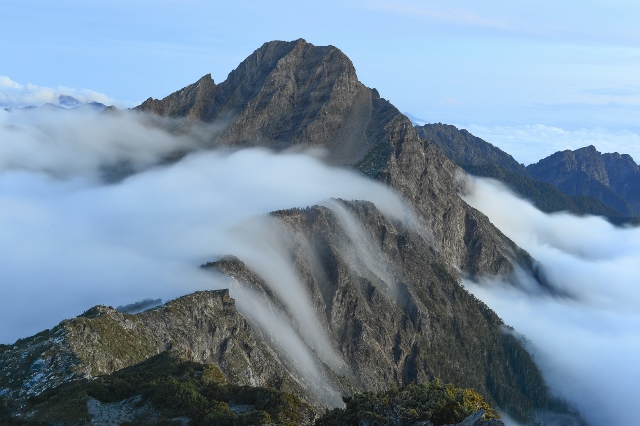Author: Dr. Ben LaPage
Photo: Construction and Planning Department,
Ministry of the Interior
Photographers: Lai, Chin-Huangy

The trek to Jade Mountain was first discussed a number of years ago with (Drs. Wei-Ta Fang and Marinus Otte). The idea was to identify the types of wetlands that might be present from the highest mountain down to the valley floor. The reason for performing this type of investigation was that there is very little known about alpine/montane wetlands in the world, apart from some of the more famous high-elevation lakes we know about.
This year a small team was assembled to visit Jade Mountain and identify the wetlands along the trek to the summit of Jade Mountain. Shortly after leaving the start of the trailhead I began to observe a new type of wetland that has never before been identified or described. The closest term that I was able to use to describe the wetland was a “vertical wetland”
There are a number of wetland classification systems that are used throughout the world (e.g., Cowardin, Ramsar) and these classification systems do a good job of describing coastal and low-lying wetlands that are arranged horizontally (flat). Does a wetland always need to be arranged horizontally? In addition, none of these classification systems describe or discuss alpine and/or montane wetlands, which was part of the reason for looking into this matter further.
I expect that the reason why these vertical wetlands were never identified or described was because they do not fit into any of the definitions used by the existing classification systems. This case is very much like that seen with vernal pools. Vernal pools are wetlands, but do not fit within the existing definition of wetlands used in existing systems of classification. This too, is a good example of the limitations classification systems place on scientists that do not question the applicability or logic associated with the classification system. All classification systems are developed for a specific purpose in mind and designing one that is all inclusive is difficult and perhaps there was never a need to have such a universal system in place. Nevertheless, inability to delineate these vertical wetlands into a standard classification system may have led to their anonymity for so long.
The vegetation that was observed in the vertical wetlands were dominated by mosses, with species of lycopsids, sellaginella, and rushes (*Juncus*), and angiosperms. Hydrology appears to be primarily surface water runoff with the mosses capturing the water needed to maintain these wetlands. There are no hydric soils in the sense of the US Army Corps of Engineers definition. Along the trail to Jade Mountain, there are abundant sedimentary rocks that are weathering at different rates. The decomposed rock appears to be composed mainly of clay, which also helps retain water.
The vertical wetlands are abundant, but not continuous over the surface of the rocks. They are generally small (a few square feet to tens of square feet), patchy, and tend to be lusher or better developed where protected from desiccation.
*Next Steps*
Given the importance of the discovery of a new type of wetland, I will be preparing a manuscript for publication in the international journal, *Wetlands*, together with Drs. Fang and Otte. We expect to publish a short communication in the next few months to let the scientific community know that vertical wetlands exist and then embark on developing a research program that can start to better understand the nature and extent of vertical wetlands. Some of the questions that need to be posed include,but are not limited to the following:
- –How do we document the nature and extent of these wetlands and characterize them?
- –Is this an old school approach?
- –Is there a vertical gradient that can be recognized (i.e., vegetation zones)?
- –Does soil chemistry drive species composition?
- –Hydrology – surface water versus ground water?
- –Are there threatened and endangered species (both plant and animal) present?
- –Are there species present that are new to science (both plant and animal)?
- –Is there a successional process?
- –What is the contribution of these wetlands to the riparian systems in the valley bottoms?


![Text size [Small]](/media/system/images/font_small.jpg)
![Text size [Medium]](/media/system/images/font_normal.jpg)
![Text size [Large]](/media/system/images/font_big.jpg)




